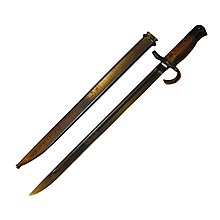Jukendō

Japanese Type 30 bayonet (1894–1945)
|
|
| Focus | Weaponry (Bayonet) |
|---|---|
| Hardness | Competitive |
| Country of origin | Japan |
| Creator | No single creator |
| Parenthood | Historical |
| Olympic sport | No |
Jūkendō (銃剣道?) is the Japanese martial art of bayonet fighting, and has been likened to kendo (but with bayonets instead of swords). Jukendo techniques are based on sojutsu (spear fighting) or bayonet techniques from the 17th century, when firearms were introduced to Japan.
During the Meiji period, Japanese bayonet fighting techniques were consolidated into a system named jukenjutsu, and taught at the Toyama military academy in Tokyo.Morihei Ueshiba, founder of aikido, trained in jukenjutsu and incorporated some of that art into his own art. Following World War II, the practice of jukenjutsu was banned by the Allies, but it later returned in the modern form of jukendo. The Japan Amateur Jukendo Federation was established in 1952. The All Japan Jukendo Federation was established in April 1956.
Modern jūkendō uses a mokujū, a wooden replica of a rifle with an attached and blunted bayonet at the end, in place of an actual rifle. The art is practised by both Japanese military personnel and civilians. Training incorporates kata (patterns), two-person drills, and competitive matches using mokujū and protective armor. The three main target areas are the heart, throat, and lower left side of the opponent.
...
Wikipedia
